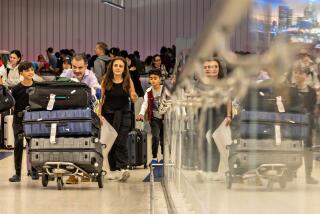Groups protest new airport pat-down technique, more body scanners
- Share via
As federal aviation officials increased airport security measures, civil liberty groups fought back, protesting new pat-down search techniques and the growing use of full-body scanners.
The Transportation Security Administration announced last week that security officers would to perform more aggressive pat-downs and vowed to approximately triple the number of full-body scanners in airports nationwide by the end of next year.
Under the new pat-down technique, TSA security officers use their palms and fingers to probe for hidden weapons and other devices. In the past, officers used the backs of their hands to brush past sensitive body parts, including breast and groin areas.
On Tuesday, TSA Administrator John Pistole told an aviation security conference in Germany that the agency plans to have deployed about 1,000 full-body scanners at airports throughout the U.S. by the end of 2011.
The more than 300 machines now installed at 65 airports use low-level radiation to detect weapons hidden under travelers’ clothes, in the process generating images that look like nude photos.
TSA screeners use the new pat-down search on passengers who opt not to go through the full-body scanners or who trigger an alarm from a metal detector. An American Civil Liberties Union spokesman called it a choice between a “virtual strip search” and a “grope.”
Also last week, the Electronic Privacy Information Center, a public interest research group in Washington, charged that use of the scanners violates passengers’ privacy. The move was part of a lawsuit filed in July against the Homeland Security Department.
The group accused TSA officers of using the scanners on all passengers regardless of levels of suspicion and of not telling passengers that they can opt not to pass through the scanner.
“It’s a highly invasive search,” said Ginger McCall, an attorney for the privacy group.
TSA spokesman Nico Melendez said the agency would not comment on pending litigation. But, he added, it has held news conferences at every airport where a full-body scanner has been added. He said TSA has also posted signs at those airports, explaining what the machines do and what options passengers have.
• Southwest deal puts AirTran’s business class in jeopardy
Business consultant Don Turner flies weekly on AirTran Airways from his home outside Atlanta to his job in Los Angeles.
But after last month’s announcement that Southwest Airlines Co. plans to buy AirTran Holdings Inc., he fears that Southwest will eliminate the business-class seats he uses on AirTran.
Turner is one of more than 500 business travelers who have signed a petition urging Southwest to keep the business-class seats. He vows to abandon his favorite airline if it does not.
Turner said he needs the extra-wide seats and wireless Internet access offered in AirTran’s business class to work on his laptop during the four-hour flights.
“You can’t work in coach,” he said. “I don’t care what other people say.”
AirTran provides 12 business-class seats in each of its 136 planes.
Southwest plans to keep its open-seating, all-coach layout after the acquisition. Southwest spokeswoman Katie Coldwell said she hoped AirTran’s customers would give Southwest a try before making a judgment.
• What drivers seek with their navigation systems
TeleNav Inc., the provider of mobile GPS technology for wireless providers such as AT&T, T-Mobile and Verizon Wireless, analyzed the places that 17 million drivers most often tried to locate in September. Here are some of the findings:
When motorists were hungry, McDonald’s was the No.1-searched eatery. When they needed to sleep, Holiday Inn Hotels & Resorts was the top-searched hotel.
Drivers who wanted to shop most often searched for Wal-Mart. And for caffeine, the TeleNav users’ overwhelming choice was Starbucks.
More to Read
Inside the business of entertainment
The Wide Shot brings you news, analysis and insights on everything from streaming wars to production — and what it all means for the future.
You may occasionally receive promotional content from the Los Angeles Times.










